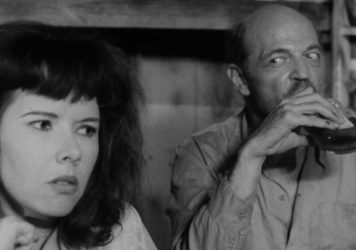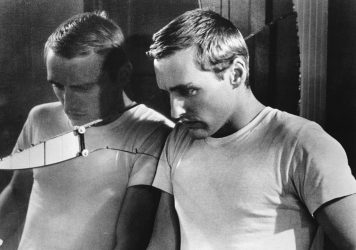
A vast gulf in style separates the bookending films of Nicolas Winding Refn’s oeuvre. His debut, Pusher, traffics in a sense of live-wire immediacy, achieved through gritty handheld camerawork and a dread-inducing, plans-gone-awry narrative. Too Old to Die Young – the television series he completed before his new Netflix show Copenhagen Cowboy – is radically different. Pushing Refn’s by-now-trademark affinity for neon and velvety electronica to experimental extremes, the ten-episode miniseries decelerates the pace to the point of attaining a molasses-like consistency. Languid zooms, pans, and tracking shots abound, poring over tableau-vivant-style staging involving static bodies arranged like mannequins in a fashion photoshoot.
These two stylistic extremes, in being so diametrically opposed, imbue Refn’s filmography with a dialogic tension, each illuminating the other’s characteristics by contrast. And yet, this tension doesn’t simply exist intertextually, between films. In 1999, they converged in Refn’s Bleeder, which, despite being only his sophomore picture, feels like a transitional work in retrospect. A meeting point between the two stylistic poles, the film is also “about” this very convergence, exploring the violence and beauty that ensue when reality and fantasy, life and art collide.
Like Pusher, Bleeder is set in working-class Copenhagen and often adopts a pseudo-vérité approach to capturing its characters’ daily activities, which include bustling in a deli kitchen, lounging around the apartment, and talking with customers at a video store. Consistent with this quotidian ethos, moments of violence are disturbingly believable when they erupt. When one of the protagonists Leo (Kim Bodnia) hits his pregnant girlfriend (Rikke Louise Andersson), the act, while not justified, is framed as emerging in some sense “organically” from the character’s temperament as well as the dead-end socioeconomic milieu that curtails his prospects for change and on top of which the burden of impending fatherhood feels like the final nail in the coffin.

Despite displaying certain realist tendencies, Bleeder also abounds with flashes of baroque stylization. At points, the film’s reliance on mundane diegetic sounds – e.g., the tinny audio of a ’70s kung-fu film, playing in the background of the video store – yields to aggressive, melodramatic needle drops, like a portentous choral refrain that imbues a nighttime drive with an apocalyptic air. Red – a deep, angry red – is a recurring color motif, infusing various moments with a phantasmagoric charge. It’s the color of Leo’s wallpaper, suggesting the latent violence within his home, and scene transitions repeatedly involve the image slowly fading to red as a deep, ominous rumbling is heard on the soundtrack.
These vivid stylistic punctuations don’t merely supplement the main drama, but, rather, seem to exist in dialogue with it, evoking the ways in which the realm of art, artifice, and fantasy mediate characters’ encounters with the world, coloring their conception of reality. Red lighting appears in a scene at a club in which Leo witnesses a shooting, an incident that inaugurates a power trip in which he becomes obsessed with buying a gun; similar, sanguineous lighting saturates the moment when he first shows off his new revolver to a friend.
At one point, he angrily brandishes his weapon while standing in the projector light of a screening of William Lustig’s Maniac, a film about a serial killer who dresses up mannequins in his victims’ attire to enact a fantasy of control. The allegorical connection to Leo’s own situation is clear enough (his assertions of power are plainly tied to feelings of impotence), but, given that the screening is part of a regular get-together between film buff friends, the scene also suggests that Leo’s macho posturing may very well have been modeled after the films he’s watched.
In Leo’s character arc, Bleeder’s meta-cinematic focus on cinephilia acquires a cautionary dimension, highlighting the dangerous (and ultimately fatal) consequences of someone attempting to turn his life movie-like. But the film also contains a more wholesome, hopeful depiction of the art-life relationship. Lenny (Mads Mikkelsen), the other protagonist and a video-store employee, spends the film trying to muster up the courage to ask out Lea (Liv Corfixen), a local deli worker. The most movie-obsessed member of his friend group, Lenny talks about little else, even to her; films are his lens onto the world.
The thing is, his approach works: Bleeder ends with plans made by the pair to see Armageddon together (a playful title choice). Furthermore, it’s through the tools of cinematic fantasy that Refn expresses the force of Lenny’s longing. In two of the film’s most euphoric moments, the image goes dark save for two spotlights illuminating Lenny and Lea, all while a pop melody plays on the soundtrack. Anticipating the famous elevator kiss from Drive, these moments suspend realism and seemingly time itself, entering a transcendent space of romantic reverie. They revel in artifice but, for that very reason, feel potently true.
Published 5 Jan 2023

We’ve teamed up with the director of Drive and The Neon Demon to bring weird cinema to the masses.

By Neil Fox
The director’s ongoing restoration project, byNWR, is breathing new life into forgotten cult movies.

With The Neon Demon the Danish writer/director has made his most provocative film yet. We travelled to Copenhagen to meet him.